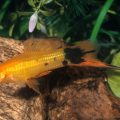Description of acanthophthalmus
These fish resemble large worms because oftheir elongated body. They get oxygen through their skin and intestines, capturing air from the surface of the water with their anus. They are omnivorous, as they feed on various waste products that fall to the bottom. Acanthophthalmus prefers to move at night, so it is difficult to see during the day. Photo: Getty General characteristics:
Acanthophthalmus prefers to move at night, so it is difficult to see during the day. Photo: Getty General characteristics:
- small head;
- a spiny spike on the head;
- three pairs of mustaches;
- corpuscular body shape;
- pink-yellow body, intersected by dark strips;
- absence of scales;
- located closer to the tail of the dorsal fin.
The thorn on the head helps it get through narrow places and plant stems. The fish grows up to 8-11 cm in length. It lives in an aquarium for at least 5 years, usually longer - 8-10 years.
The content and care of acanthophthalmus
Fish is a great helper in the fight for cleanlinessaquarium, as it eats the remains of food that have fallen to the bottom. This fish is well adapted to life in an aquarium and gets along without problems with the peaceful inhabitants of its home. It almost always lives on the bottom and prefers to lead a secretive lifestyle. The fish is especially active at night, it is difficult to notice during the day. But if there are 6-10 fish of this species in the aquarium, they behave more actively. The fish have no scales, so its skin is very susceptible to medications. Therefore, they must be treated very carefully. Fish love spacious reservoirs, so the aquarium should hold at least 100 liters of water. It is better for the reservoir to have a larger area. It is better to cover aquariums, as the acanthophthalmus fish can jump out of the water and die. Most often, such incidents occur when atmospheric pressure drops and the weather changes. The fish become restless, begin to move quickly and chaotically and even jump. The water should be clean and well aerated. The optimum temperature is from 22 to 30 degrees. It needs to be changed frequently and the soil needs to be siphoned, cleaning it of waste. There should be sand or small pebbles and lots of shelters at the bottom of the aquarium. Driftwood, thickets of plants, rhizomes and stone castles will help recreate the natural habitat of the fish. In nature, they burrow into the soil of reservoirs and live under the rhizomes of trees and plants. It is best to get these fish if you feed other inhabitants of the aquarium with small live food. Small and nimble worms will quickly eat up the remains of food, helping you to keep the reservoir clean. If properly cared for, it can live in captivity for 5-6 years. Read also:









